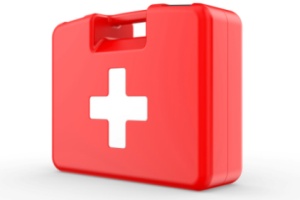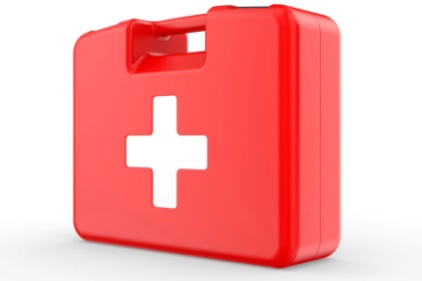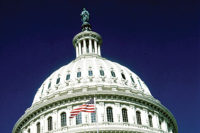 The following information comes from Medline Plus, a service of the U.S. National Library of Medicine,
The following information comes from Medline Plus, a service of the U.S. National Library of Medicine,
National Institutes of Health. As noted below, the first aid directions are of a general advisory nature and are not intended to be applied without the consultation and assessment on on-site first aid providers. They are in the best, most knowledgeable position to provide care and treatment.
The human body conducts electricity very well. That means electricity passes very easily throughout the body. Direct contact with electrical current can be deadly. While some electrical burns look minor, there still may be serious internal damage, especially to the heart, muscles, or brain.
Electric current can cause injury in three ways:
- Cardiac arrest due to the electrical effect on the heart
- Muscle, nerve, and tissue destruction from a current passing through the body
- Thermal burns from contact with the electrical source
Causes
- Accidental contact with exposed parts of electrical appliances or wiring
- Flashing of electric arcs from high-voltage power lines
- Lightning
- Machinery or occupational-related exposures
- Young children biting or chewing on electrical cords, or poking metal objects into an electrical outlet
Symptoms
Symptoms depend on many things, including the type and strength of voltage, how long you were in contact with the electricity, how it moved through your body, and your overall health.
Symptoms may include:
- Changes in alertness (consciousness)
- Broken bones
- Heart attack
- Headache
- Problems with swallowing, vision, or hearing
- Irregular heartbeat
- Muscle spasms and pain
- Numbness or tingling
- Breathing problems or lung failure
- Seizures
- Skin burns
First Aid (Note: this is advisory information only; it is not intended as definitive steps to follow since specific circumstances are not known; you must contact and consult on-site first aid providers for assessment and treatment.)
- If you can do so safely, turn off the electrical current. Unplug the cord, remove the fuse from the fuse box, or turn off the circuit breakers. Simply turning off an appliance may NOT stop the flow of electricity. Do NOT attempt to rescue a person near active high-voltage lines.
- Call your local emergency number, such as 911.
- If the current can't be turned off, use a non-conducting object, such as a broom, chair, rug, or rubber doormat to push the person away from the source of the current. Do not use a wet or metal object. If possible, stand on something dry that doesn't conduct electricity, such as a rubber mat or folded newspapers.
- Once the person is away from the source of electricity, check the person's airway, breathing, and pulse. If either has stopped or seems dangerously slow or shallow, start first aid. (See: CPR)
- If the person has a burn, remove any clothing that comes off easily, and rinse the burned area in cool running water until the pain subsides. Give first aid for burns.
- If the person is faint, pale, or shows other signs of shock, lay him or her down, with the head slightly lower than the trunk of the body and the legs elevated, and cover him or her with a warm blanket or a coat.
- Stay with the person until medical help arrives.
- Electrical injury is frequently associated with explosions or falls that can cause additional severe injuries. You may not be able to notice all of them. Do not move the person's head or neck if the spine may be injured.
DO NOT
Stay at least 20 feet away from a person who is being electrocuted by high-voltage electrical current (such as power lines) until the power is turned off.
- Do NOT touch the person with your bare hands if they are still in contact with the source of electricity
- Do NOT apply ice, butter, ointments, medications, fluffy cotton dressings, or adhesive bandages to a burn
- Do NOT remove dead skin or break blisters if the person has been burned
- After the power is shut off, do NOT move the person unless there is a risk of fire or explosion
When to Contact a Medical Professional
Call your local emergency number, such as 911 if a person has received an electrical burn.
Prevention
- Avoid electrical hazards at home and at work. Always follow manufacturer's safety instructions when using electrical appliances
- Avoid using electrical appliances while showering or wet
- Keep children away from electrical devices, especially those that are plugged in
- Keep electrical cords out of children's reach
- Never touch electrical appliances while touching faucets or cold water pipes
- Teach children about the dangers of electricity
- Use child safety plugs in all outlets
Burns
There are three levels of burns:
-
First-degreeburns affect only the outer layer of the skin. They cause pain, redness, and swelling.
Second-degree(partial thickness) burns affect both the outer and underlying layer of skin. They cause pain, redness, swelling, and blistering - Third-degree(full thickness) burns extend into deeper tissues. They cause white or blackened, charred skin that may be numb.
Considerations
Before giving first aid, evaluate how extensively burned the person is and try to determine the depth of the most serious part of the burn. Then treat the entire burn accordingly. If in doubt, treat it as a severe burn.
By giving immediate first aid before professional medical help arrives, you can help lessen the severity of the burn. Prompt medical attention to serious burns can help prevent scarring, disability, and deformity. Burns on the face, hands, feet, and genitals can be particularly serious.
Children under age 4 and adults over age 60 have a higher chance of complications and death from severe burns.
In case of a fire, you and the others there are at risk for carbon monoxide poisoning. Anyone with symptoms of headache, numbness, weakness, or chest pain should be tested.
Causes
Burns can be caused by dry heat (like fire), wet heat (such as steam or hot liquids), radiation, friction, heated objects, the sun, electricity, or chemicals.
Thermal burns are the most common type. Thermal burns occur when hot metals, scalding liquids, steam, or flames come in contact with your skin. These are frequently the result of fires, automobile accidents, playing with matches, improperly stored gasoline, space heaters, and electrical malfunctions. Other causes include unsafe handling of firecrackers and kitchen accidents (such as a child climbing on top of a stove or grabbing a hot iron).
Burns to your airways can be caused by inhaling smoke, steam, superheated air, or toxic fumes, often in a poorly ventilated space.
Burns in children are sometimes traced to parental abuse.
Symptoms
- Blisters
- Pain (the degree of pain is not related to the severity of the burn -- the most serious burns can be painless)
- Peeling skin
- Red skin
- Shock(watch for pale and clammy skin, weakness, bluish lips and fingernails, and a drop in alertness)
- Swelling
- White or charred skin
Symptoms of an airways burn:
- Charred mouth; burned lips
- Burns on the head, face, or neck
- Wheezing
- Change in voice
- Difficulty breathing; coughing
- Singed nose hairs or eyebrows
- Dark, carbon-stained mucus
First Aid (Note: this is advisory information only; it is not intended as definitive steps to follow since specific circumstances are not known; you must contact and consult on-site first aid providers for assessment and treatment.)
FOR MINOR BURNS
- If the skin is unbroken, run cool water over the area of the burn or soak it in a cool water bath (not ice water). Keep the area submerged for at least 5 minutes. A clean, cold, wet towel will also help reduce pain.
- Calm and reassure the person.
- After flushing or soaking, cover the burn with a dry, sterile bandage or clean dressing.
- Protect the burn from pressure and friction.
- Over-the-counter ibuprofen or acetaminophen can help relieve pain and swelling. Do NOT give children under 12 aspirin. Once the skin has cooled, moisturizing lotion also can help.
- Minor burns will usually heal without further treatment. However, if a second-degree burn covers an area more than 2 to 3 inches in diameter, or if it is located on the hands, feet, face, groin, buttocks, or a major joint, treat the burn as a major burn.
- Make sure the person is up to date on tetanus immunization.
FOR MAJOR BURNS
- If someone is on fire, tell the person to stop, drop, and roll. Wrap the person in thick material to smother the flames (a wool or cotton coat, rug, or blanket). Douse the person with water.
- Call 911.
- Make sure that the person is no longer in contact with smoldering materials. However, do NOT remove burned clothing that is stuck to the skin.
- Make sure the person is breathing. If breathing has stopped, or if the person's airways are blocked, open the airways. If necessary, begin rescue breathing and CPR.
- Cover the burn area with a dry sterile bandage (if available) or clean cloth. A sheet will do if the burned area is large. Do NOT apply any ointments. Avoid breaking burn blisters.
- If fingers or toes have been burned, separate them with dry, sterile, nonadhesive dressings.
- Elevate the body part that is burned above the level of the heart. Protect the burn area from pressure and friction.
- Take steps to prevent shock. Lay the person flat, elevate the feet about 12 inches, and cover the person with a coat or blanket. However, do NOT place the person in this shock position if a head, neck, back, or leg injury is suspected or if it makes the person uncomfortable.
- Continue to monitor the person's vital signs until medical help arrives. This means pulse, rate of breathing, and blood pressure.
DO NOT
- Do NOT apply ointment, butter, ice, medications, cream, oil spray, or any household remedy to a severe burn.
- Do NOT breathe, blow, or cough on the burn.
- Do NOT disturb blistered or dead skin.
- Do NOT remove clothing that is stuck to the skin.
- Do NOT give the person anything by mouth, if there is a severe burn.
- Do NOT immerse a severe burn in cold water. This can cause shock.
- Do NOT place a pillow under the person's head if there is an airways burn. This can close the airways.
When to Contact a Medical Professional
Call 911 if:
- The burn is extensive (the size of your palm or larger).
- The burn is severe (third degree).
- You aren't sure how serious it is.
- The burn is caused by chemicals or electricity.
- The person shows signs of shock.
- The person inhaled smoke.
- Physical abuse is the known or suspected cause of the burn.
- There are other symptoms associated with the burns
Call a doctor if your pain is still present after 48 hours.
Call immediately if signs of infection develop. These signs include increased pain, redness, swelling, drainage or pus from the burn, swollen lymph nodes, red streaks spreading from the burn, or fever.
Also call immediately if there are signs of dehydration: thirst, dry skin, dizziness, lightheadedness, or decreased urination. Children, elderly, and anyone with a weakened immune system (for example, HIV) should be seen right away.
Prevention
To help prevent burns:
- Install smoke alarms in your home. Check and change batteries regularly.
- Teach children about fire safety and the hazards of matches and fireworks.
- Keep children from climbing on top of a stove or grabbing hot items like irons and oven doors.
- Turn pot handles toward the back of the stove so that children can't grab them and they can't be accidentally knocked over.
- Place fire extinguishers in key locations at home, work, and school.
- Remove electrical cords from floors and keep them out of reach.
- Know about and practice fire escape routes at home, work, and school.
- Set temperature of water heater at 120 degrees or less.

